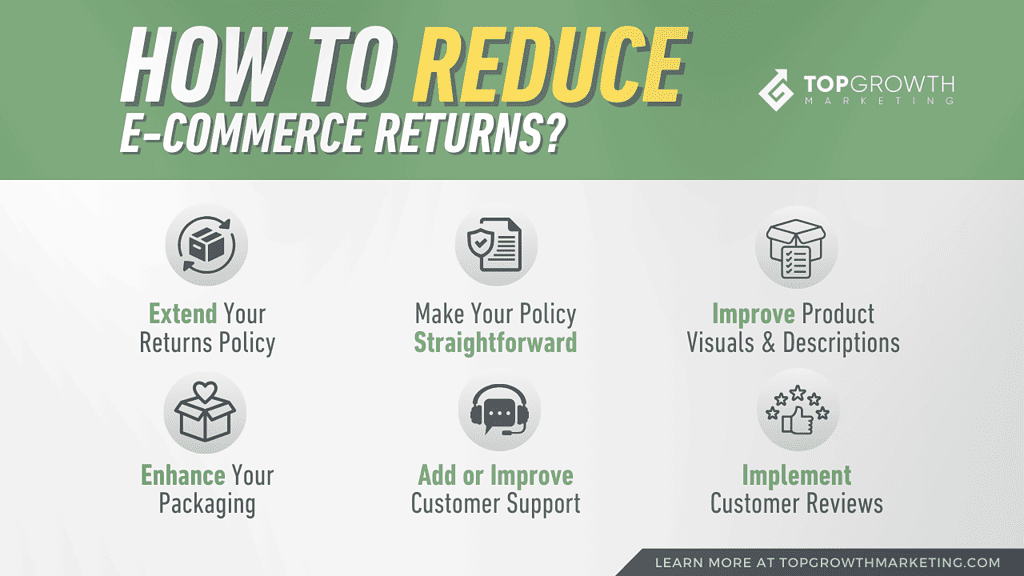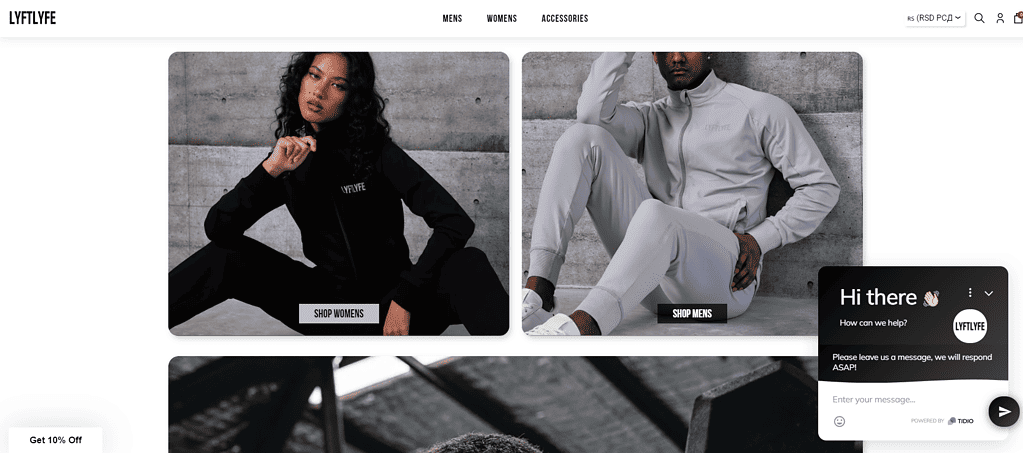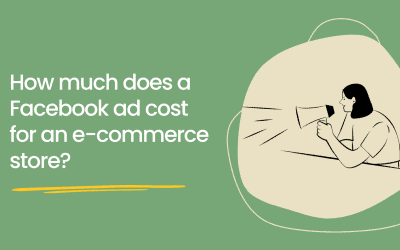Ecommerce returns cause significant financial and logistical troubles, creating huge bottlenecks for online retailers.
Most notably, they are hurting profit margins and disrupting supply chains.
Therefore, reducing these returns is imperative for improving profit margins and predictable scaling and making your customers more satisfied.
As an eCommerce marketing agency, we know how serious of an issue this is. And we have prepared a few ultimate tactics to help you.
But first, here’s more info on why returns can be storeowners’ downfall.
Why You Should Take Ecommerce Returns Seriously
Ecommerce returns are causing a financial hit that’s hard to ignore.
About 16.5% of retail sales in 2022 were sent back, reaching a value of $212 billion.
Even worse, $22.8 billion worth of these were deemed fraudulent, making for yet another ecommerce issue.
It’s not just about the money, though – bad returns also affect how likely people are to shop again. In fact, 65% of shoppers admitted they are less likely to shop after a negative return experience.
Stores are feeling the sting even harder than the buyers, as 73% of them ranked returns as a major issue they face.
Perhaps not that surprising, considering how returns make up approximately 20% to 30% of all sales.
and here’s the kicker: even with receipts, people are getting increasingly worried about fraud. Expectations of fraud – even with a receipt – jumped 43% from last year, from 9.8% to 14%.
With so many online purchases going back to the stores, ignoring returns isn’t an option anymore. It’s a cycle that’s hard to break, and it’s not just about losing sales – the cost of processing these returns adds up too.
Businesses must work around this challenge to maintain customer loyalty, build trust, and ensure financial stability.
How to Decrease Ecommerce Returns? (Step-by-Step)
Now that you know how dangerous returns can be for Shopify stores, here are some of the best ways of ensuring they happen less often.
Extend Your Returns Policy
Crafting a liberal, customer-centric returns policy may seem strategically counterintuitive at first.
Take the endowment effect, for instance. This fascinating psychological phenomenon suggests that individuals tend to overvalue items they possess.
More specifically, giving them more freedom in terms of product returns makes them more eager to keep the product.
A longer returns policy is a prime example.
The extended returns window made buyers feel trust and assurance, leading to fostering a deeper connection with the brand. They felt that their satisfaction was a top priority.
More often than not, brands doing this even encounter an upsurge in repeat purchases, showing how long of a way a liberal returns strategy can go.
Make Your Returns Policy as Straightforward as Possible
Having a straightforward return policy is crucial for every business.
For online stores, it’s paramount because it sets clear rules, preventing customers from abusing your policy.
On the other hand, it reassures them that shopping from your store is risk-free. They feel much more confident when they know that they can return items that don’t fit their needs.
A good return policy needs to be easily understood. It should clearly state the time frame for returns and provide simple steps for the buyers to follow. Also, this policy must be accessible for customers without having to navigate through multiple pages.
Statistics show that 92% of customers with a positive return experience will gladly make repeat purchases.
This goes to show that customers will trust your store more if you make sure that their returns are carefree, making for higher profit margins.
Improve Your Product Descriptions and Visuals
Providing an immersive buying experience is yet another way of reducing returns.
You can do this by creating a virtual shopping experience that bridges the gap between physical and online retail.
Detailed and accurate product descriptions serve as the online counterpart to physical touch and inspection in traditional stores.
A robust description informs customers about the product’s features, materials, dimensions, and functionalities.
Clear product descriptions help manage expectations, reducing the likelihood of dissatisfaction upon delivery.
Moreover, they can build trust and confidence, leading to more informed purchasing decisions. You can also consider using multilingual ecommerce solutions and provide product description in different languages to reach a broader audience.
However, they should also be accompanied by compelling visuals. High-quality images or videos showcasing the product from various angles, in different contexts, or being used, provide customers with a tangible understanding of what they’re buying.
It helps mitigate doubts about the product’s appearance or quality, consequently minimizing the chances of failed purchases.
On top of all this, if your store sells apparel and accessories, size guides are indispensable. Clear and accurate sizing information aids customers in choosing the right fit. Providing measurements and fit recommendations are another good way of ensuring more considerate decisions.
Enhance Your Packaging
Studies state that 25% of shipped products were returned due to damage in 2023. Think about it – that’s every fourth shipment worldwide!
Packaging isn’t just about aesthetics, but preventing shipping-induced harm. Robust packaging, when executed thoughtfully, ensures that the product remains intact throughout the shipping process.
Employing sturdy materials, strategic cushioning, and appropriate labeling techniques are instrumental in protecting the shipment.
Without proper packaging, products are vulnerable to mishaps during transit, leading to an increased likelihood of returns due to damage. Each dent or crack not only impacts the product’s physical condition but also tarnishes the customer’s buying experience.
Investing in reliable packaging serves as an investment in customer satisfaction, but also long-term cost reduction. The latter is explained by the fact that strengthening the packaging significantly minimizes the risk of returns caused by damaged goods.
Add Customer Support to Your Store
Effective customer support, particularly real-time assistance, can greatly reduce eCommerce returns by tackling various factors leading to returns. Even better, Shopify integrates live chat, offering instant communication with customers.
Live chat or responsive email support should help them resolve uncertainties that would otherwise result in an inevitable return. Preemptively addressing your customers’ potential issues will instill confidence and clarity in them, making for informed buying choices.
However, to reap the full benefits of real-time or delayed support, it’s important to use both in moderation. Over-reliance on these could negatively impact the experience, as untrained support agents or aggressive selling may deter customers.
Implement Customer Reviews (and Encourage People to Leave Them!)
Customer reviews can reduce eCommerce returns by offering valuable insights and guidance to prospective buyers.
Leveraging reviews that specifically address product attributes like size, color, and functionality aids potential customers in making informed decisions, reducing uncertainty about the product’s suitability.
It gets even better if a review is accompanied by photos. They can better display sizing accuracy or color representation, which further contributes to a more transparent buying experience, setting realistic expectations.
This is another great way of bridging the gap between the online product description and the actual product.
Furthermore, you can – and should! – encourage customers to leave reviews.
You can initiate loyalty programs, offer discounts on future purchases, or conduct giveaways for reviewers.
Acknowledging and rewarding customers who take the time to leave detailed and helpful reviews not only encourages more feedback but also fosters a sense of community and engagement around the brand.
And finally – don’t forget to highlight the most helpful reviews on your product pages!
Returns – reduced!
Overwhelming eCommerce returns can severely harm both finances and customer relationships. They disrupt profit margins, hinder scalability, and erode consumer trust.
These six strategies can help your store secure long-term success in the dynamic eCommerce landscape. We highly recommend that you implement all of them.
If you already have experience with any of them, we would love it if you could let us know how that worked out.










0 Comments